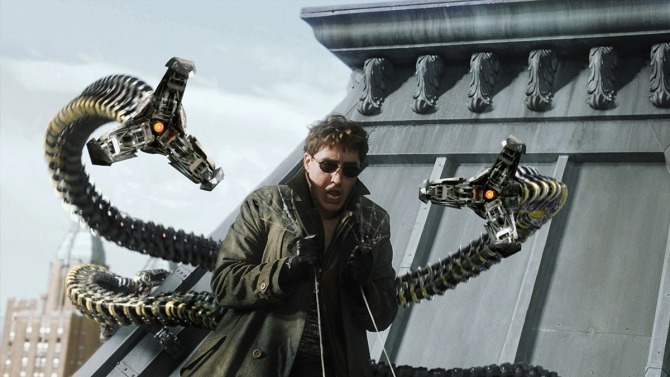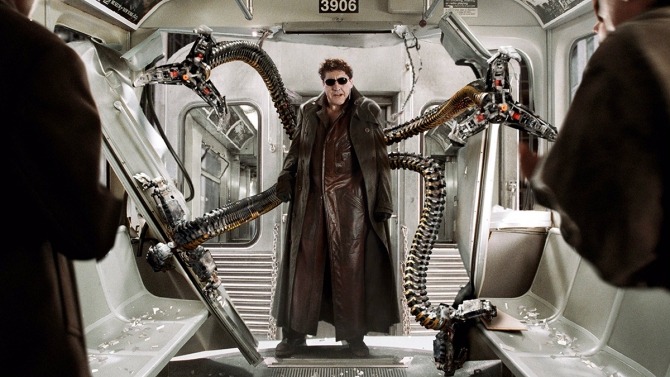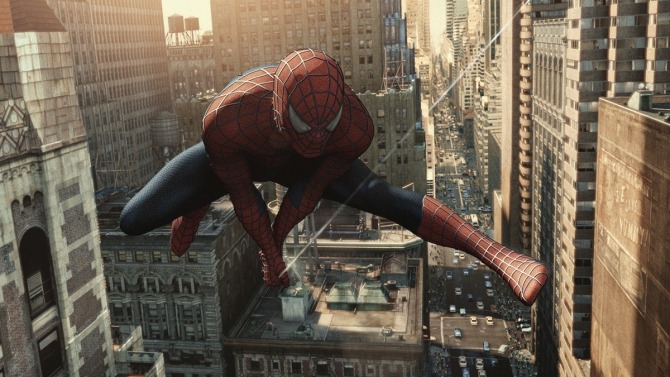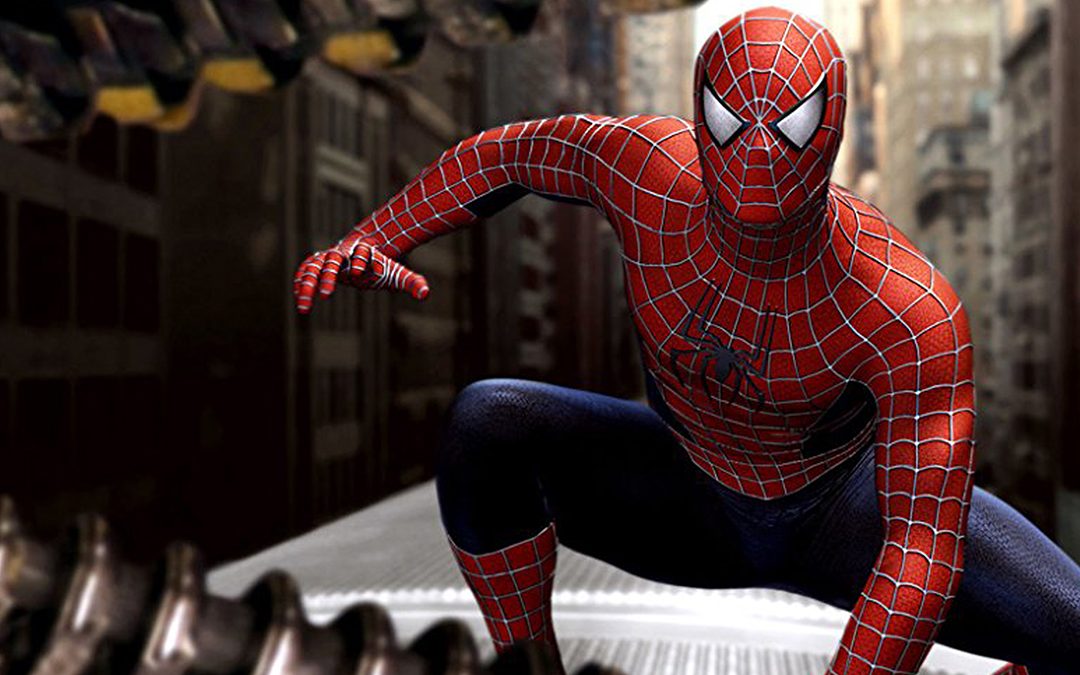This feature contains spoilers for Spider-Man 2, and for Insomniac’s Spider-Man game.
“It’s good to have you back, Spider-Man.”
It’s been almost 15 years since the release of Sam Raimi’s Spider-Man 2 and, for some, it’s yet to be surpassed. Even though the overall quality and variety of comic-book movies have significantly improved since 2004, when the only other examples to be had were Blade: Trinity and the second run at The Punisher, the first Spidey sequel just works in a way that even the very best Marvel Studios movies have seldom matched.
Starting a year or so after the first film, Spider-Man 2 picks up with Tobey Maguire’s Peter Parker still struggling to balance his job, his college studies, and his personal life with the great responsibility part of his great power. Desperately in love with Kirsten Dunst’s Mary Jane Watson, he just can’t catch a break. As stress overwhelms him, even Peter’s spider-powers start to fail him, causing him to turn his back on being Spider-Man in order to sort his life out.
While some prefer the modern consistency of the MCU to the nostalgic Silver Age optimism of Raimi’s take, Spider-Man 2 is a triumph of comic-book cinema that absolutely holds up to this day. It follows then, that the film’s best qualities come through most brilliantly in the sequence that is universally agreed to be its best.
Quite aside from being a better superhero action scene than anything else we had seen up to that point, there are a number of reasons why the fight between Spider-Man and Alfred Molina’s Doctor Octopus atop and around a runaway subway train is the heart of the movie. Representing the very best we’ve seen of Spider-Man on the big screen to date, it’s the build-up and the aftermath that cements this sequence as one of the greats.
‘Do you love me, or not?’
Adapting the classic comic arc, “Spider-Man No More!”, the film is intrinsically about the personal toll that being Spider-Man takes on Peter. His failing powers are an emotional problem, not a physical one, and over the course of the plot, we have to see him come to terms with this. Peter is easy to root for in the first place, so even though the film doesn’t quite reconcile the emergence of an eight-limbed supervillain with the timing of Spider-Man’s brief retirement, the film explores this in a more sensitive way.
First, Raimi follows the excellent Raindrops Keep Falling On My Head montage with a scene in which Peter witnesses a mugging that Spider-Man could easily stop, and guiltily walks on. That guilt directly spurs his admission to Aunt May that he could have stopped the man who killed Uncle Ben (threequels notwithstanding) but doesn’t admit his secret identity. Rosemary Harris’ performance is such that you can’t tell if she already knows or not, really.

The next action sequence comes when Peter bravely tries to rescue people from a burning apartment building, without the help of his powers. It’s rare for superhero movies to really make you fear for the hero’s safety, but this does the job nicely. With some effort, Peter makes it out alive, but the scene is buttoned by a realisation that he didn’t manage to save everyone this time.
When Doc Ock does re-emerge to present a real, superpowered threat, it comes in a scene that formed the basis of Spider-Man 2’s very first teaser trailer. Having got used to the idea that he might be able to enjoy his own life, Peter has to sit across from Mary Jane and tell her, again, that he doesn’t want to be with her.
The film works hard to set up that being Spider-Man is a thankless job, but it does so in a way that is utterly engrossing and entertaining. Peter just can’t catch a break, right down to stopping off at J. Jonah Jameson’s office to retrieve his suit at the exact right moment to confirm all of the editor’s biases about him.
The triumphal note isn’t just that “HE’S BACK”, as the subsequent Daily Bugle headline trumpets, but that he’s prepared to continue in spite of everything the film has thrown at him. Once we’re all aboard with that, the film really lands its most spectacular fight scene.
‘You have a train to catch’
After a quick skirmish on the face of a clock tower, Spidey and Doc Ock tumble onto the top of a passing train and the punch-up begins in earnest. Having briefly battled earlier in the film while Peter was experiencing performance issues, the film maintains the sense that Spider-Man is outmatched by the thrashing mechanical limbs throughout the subsequent fight scene.
The audience knows that Octavius is planning to take him alive, as part of a deal with Harry Osborn, but the jeopardy comes from giving Spider-Man the kind of problem that a more powerful hero would solve more easily.
So, when Spider-Man starts to gain the upper hand, Doc Ock sends the packed commuter train speeding towards a dead end without brakes and sods off. Later superhero movies like Avengers: Age Of Ultron and this year’s Incredibles 2 also have scenes where heroes take different approaches to stop a runaway train, but both feature either more powerful or more experienced characters.
Peter may be able to do whatever a spider can, but his particular set of skills isn’t necessarily suited here. Some viewers still argue about the physics of his somewhat impractical solution which involves shooting webs at the surrounding buildings in order to stop a speeding train. Heck, there was even a cheeky nod to the physics of it in Insomniac’s recent Spider-Man game for the PS4.
Going all the way back to “You will believe a man can fly”, superhero cinema has always been more about entertainment and emotional investment than real-world rules. All nitpicks and jokes about Maguire’s strained expression aside, Peter’s heroic efforts to keep the train from crashing through the end of the line have all the benefit of knowing what’s on the line. It’s the aftermath that marks this sequence as a watershed in the genre.

During his exertions, Peter has lost his mask and as the webbed-up train grinds to a stop, he finally passes out. Gently carried back into the carriage by the grateful passengers, Spider-Man’s identity is revealed to a carriage full of strangers.
“He’s just a kid,” one of them observes. “No older than my son.”
Everything about the tension of this moment works. For the entire film up to that point, Peter’s secret double life has caused problems. We’ve seen him wrestle with telling his loved ones that he’s Spider-Man, realising that he could save himself a lot of bother. And then he’s outed to a bunch of random New Yorkers.
The “we won’t tell nobody” of it all is a peerless emotional payoff to that thread. It’s the optimism of Raimi’s take on the film, summed up at the climax of its standout scene. You could say it’s a more refined version of the beat during the original film’s climax, where an unlikely bunch of bystanders on a bridge heckle the Green Goblin and throw stuff at him, accepting Spidey as one of their own.
It’s a bigger swing, but it’s neither cloying nor sentimental, it’s just a deserved validation of why Peter does what he does, right when he needs it the most. And of course, it could never happen in a 2018 version of the same scene. Granted, Spidey is just about the only character in the MCU movies with a secret identity, but it’s precluded by today’s culture more than any sense of “they don’t make them like this anymore.”
Even if we shed every ounce of cynicism about human nature, it’s impossible to credit that somebody wouldn’t unthinkingly tweet a picture of Peter unmasked before the magic moment of consensus comes about.
‘Isn’t it time somebody saved you?’
Off the back of that moment, the three main supporting characters all find out about Peter’s secret identity too. Harry finds that his evening plans to kill Spider-Man are somewhat flummoxed by the revelation that his best friend is also the person he hates most in the world. After tangling with Spidey again, Doc Ock is won over by Peter’s more personal appeal to stop the tritium experiment before it blows up the city. And finally, MJ understands why he’s been so flaky.
For sheer emotional resonance, it’s the most satisfying ending to any of the various Spider-Man movies that have come along since. Spider-Man 3 has great parts in it, (and that’s an article for another time) but with its shoe-horned symbiote sub-plot and messy construction site showdown, never measures up to the brilliance of its predecessor.
Then came the reboots. Both Amazing Spider-Man movies spend a weird amount of time on Peter beating up baddies rather than necessarily helping people. A daring rescue scene in which he reassures a frightened child by giving him his mask is the closest that Spider-Man gets to being Spider-Man in either of those movies, but was roundly criticised by fans who thought that Andrew Garfield spent too much time unmasked. The subsequent boost by New York’s construction crane drivers in the third act feels more like the Green Goblin moment than the train bit.

Spider-Man: Homecoming wisely focuses on other priorities, in a world where superheroes are commonplace at this point in the MCU timeline. Although he’s still concealing his identity, Peter’s alter-ego is a viral hit on YouTube, and the ferry scene (which feels more of a set with certain other purely functional escapades in Marvel Studios outings) has a nice gag about it where a passenger immediately switches to cheering Iron Man, the more famous hero.
Even in the midst of the sprawling, character-stuffed Avengers: Infinity War – a mammoth superhero team-up that inevitably leaves much less time to touch base with characters and their motivations than the solo films – Tom Holland’s plucky, eager-to-please take on Spidey feels more influenced by Maguire than by Garfield.
Even while its tone and its success have been influential on several subsequent comic book films, Spider-Man 2 still feels like a one-off. Though not without some of the bugbears that are attached to the era before the current cinematic golden age of superheroes, Spider-Man 2 has rarely – if ever – been matched for sheer emotional investment.

